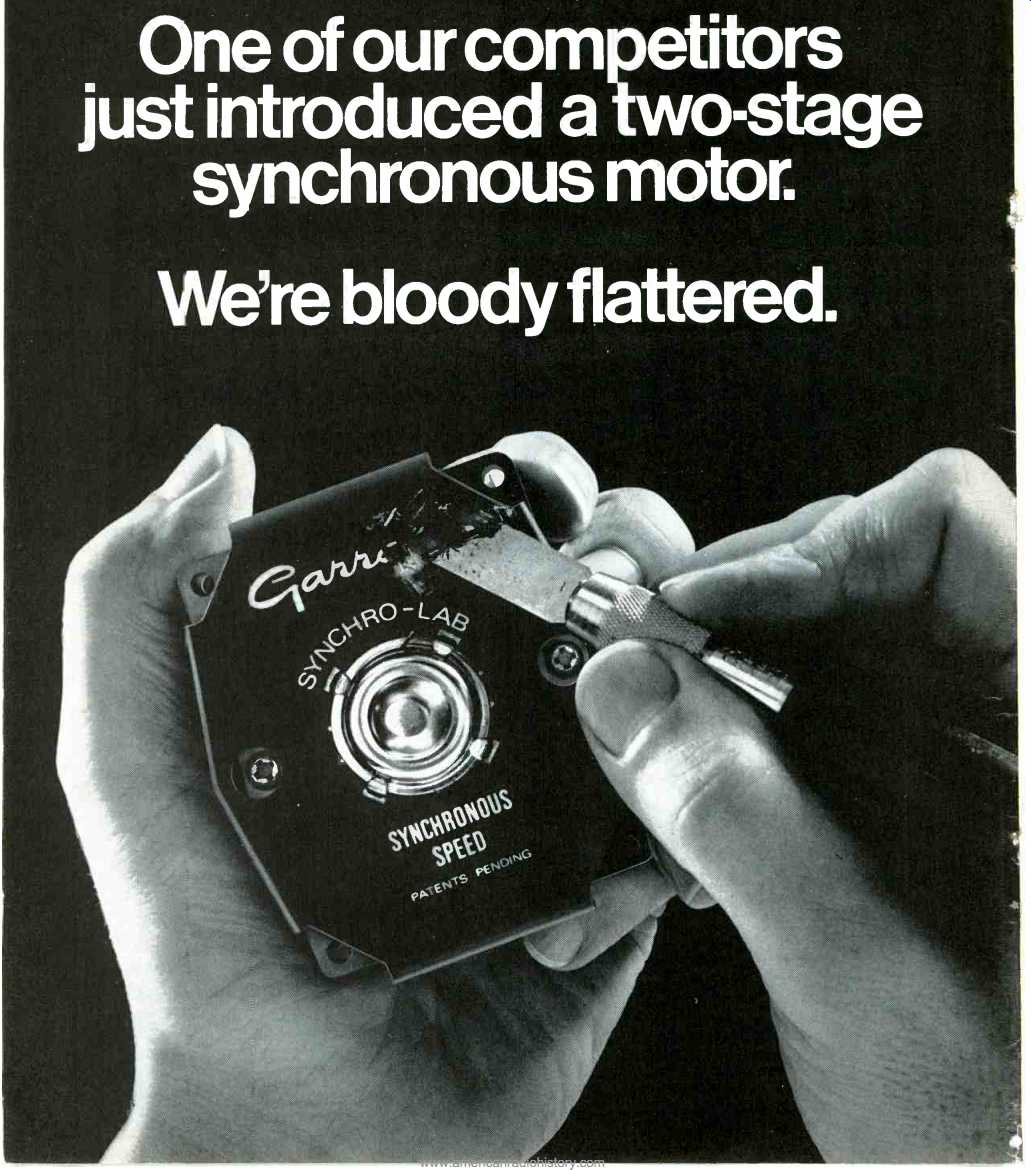
One of our competitors just introduced a two-stage synchronous motor.
We're bloody flattered.
In 1967, Garrard engineers perfected the Synchro-Lab motor. A revolutionary two-stage synchronous motor.
Revolutionary because, for the first time in a component turntable, it successfully combined two types of motor: induction and synchronous.
The induction portion supplies the torque to reach playing speed instantly.
The synchronous section then "locks in" to the 60cycle frequency of the current.
This produces unvarying speed, and thus unvarying pitch, despite variations in voltage.
A missed point
Not surprisingly, a competitor has introduced a copy of our Synchro-Lab motor on their costliest model.
Alan Say, our Chief Engineer, comments. "We're bloody flattered.
After all, being imitated is a rather good indication of how significant an innovation really is.
"But, curiously, they seem to have missed the point.
"With a nonsynchronous motor, you need a heavy turntable. Its momentum makes up for fluctuations in motor speed.
"Our purpose was to achieve constant speeds, using a lighter turntable and the least possible power. Less power and a low mass table help reduce rumble. And relieve mechanical stresses all 'round.
"When we went to the Synchro-Lab motor, we cut our turntable weight to three pounds. They're still using a seven pound disc.
"So, while others are following our lead, there's no comparison yet.
"Quite selfishly, we're pleased on both counts."
H. V.'s commitment
This is, by no means, the first time a Garrard innovation has been imitated.
Spurred by a commitment of some thirty years standing, Garrard engineers have recorded every major advance in automatic turntables.
H. V. Slade, a co-founder and Garrard of England's uncompromising Managing Director from 1918-61, set policy which endures to this day.
"We will sell a Garrard in the U.S. only when it is more advanced than any machine available there."
Satisfyingly dissatisfied
"To fulfill such an unbending commitment," points out Alan Say, "requires chaps who are perpetually dissatisfied." The 1970 Garrards would seem to bear that out.
Last year, we added viscous damped tone arm descent for gentler, safer cueing.
But offering an automatic turntable that was undamped in automatic cycle ran crossgrain of logic. So one of our engineers devised a linkage system between the changing mechanism and the damping "jack". Now Garrard's tone arm is damped in automatic.
This year, a popular and exclusive Garrard feature--our disappearing record platform--has become a non disappearing record platform.
Someone at our Swindon labs discovered we could make it a bit larger and stronger that way. A small advantage, and a difficult decision.
But one that would have pleased H. V. And we've added a counterweight adjustment screw to our gimbal suspended tone arm. It permits you to balance the arm to within a hundredth of a gram.
To quote our Mr. Say, "Anyone with a touch sensitive enough to take full advantage of it should be cracking safes with the Lavender Hill Mob."
An embarrassment of riches
You can select from not one, but six Garrard component models. Prices range from the SL95B (left) at $129.50 to the 40B at $44.50. Although prices vary from model to model, Garrard standards do not. Only the number of refinements possible at each price.
It can be a most difficult choice. Your dealer can help you make it.
Garrard

(Audio magazine, Feb. 1970 )
= = = =
Also see:
Garrard SL95B turntable (Apr. 1970)
Garrard Zero 100 turntables (ad, April 1978)
Garrard GT55 turntable (Dec. 1976)